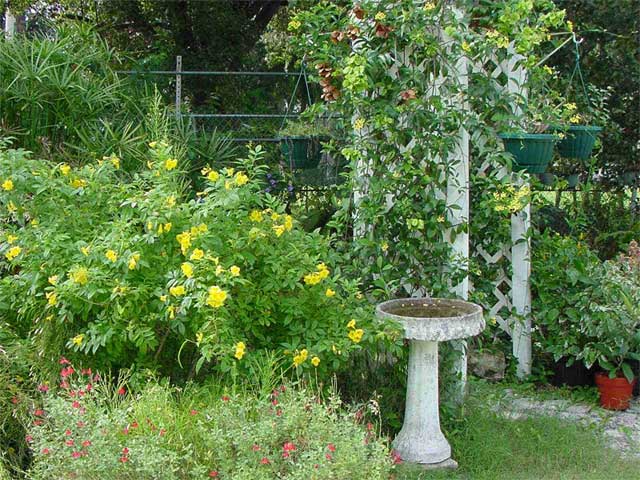and bring home the beauty of real Florida.
Visit FloridaNativeNurseries.org

The first step in making your landscape sustainable is to understand what you have.
Identify all the plants on your property, so that you can determine which to keep, which to remove right away, which need to be replaced over time, and how you can add plants in an ecologically sensible way. Don’t automatically dismiss plants that “look weedy” – you might be surprised to find out what role they plan in the natural world. And as you learn about your plants, your view of what’s attractive may change.
To identify your plants, examine photos and descriptions on this site and in Florida gardening books and websites (see our links for references). Take full stems with multiple leaves (and fruits and flowers, if available) to your county extension service for identification (for locations, check your phone book or this website: http://extension.ifas.ufl.edu/map/). You can also take plant samples to meetings of your local Florida Native Plant Society (FNPS) chapter.
If you have a lot of acreage, you might want to hire a professional with a botanical or ecological background. Proper plant identification is often beyond the capability of ordinary landscape/lawn services or garden center staff.
Make a list of all your plants with common name, scientific name, and origin (native or exotic). Scientific names are very important because they unambiguously identify your plant, whereas one common name may apply to several entirely different plants. Common names also vary from one region to the next. Common names are fun and easy to remember. But scientific names are essential, reliable keys to critical information such as origin, natural habitat, wildlife value, and light and moisture requirements.
Plan to keep plants that meet all of the following criteria: (1) healthy, (2) suitably placed, (3) thrive with no irrigation, fertilizer, or pesticide use; and (4) are not invasive exotics. You can add biodiversity and visual richness with additional native plants.
When it comes to plant health, exercise caution. Too many unscrupulous landscapers and “tree services” advise removal and trimming that may be unnecessary and harmful. Get input from multiple sources including your county extension service. Examine the credentials of firms you consult with – look for certified arborists and horticultural professionals.
Check your exotic plants against the invasive plant lists published by the Florida Exotic Pest Plant Council. FLEPPC lists exotic weeds that damage Florida’s environment, economy, and public health by disrupting ecosystems and displacing native species. Scientists now consider invasive species to be one of the top threats to the natural environment. Immediately remove and destroy any Category 1 (the worst) pest plants in your yard and make plans to replace any Category 2 (potentially threatening) plants. FLEPPC and your extension office can advise you on the safest, most effective removal methods.
If you’re purchasing wooded property, insist that it be declared free of invasive weeds by a professional botanist or weed specialist before you seal the deal. Make sure valuable native plants are identified and protected when the seller cleans up the invasive mess.
Unfortunately, too many people view plants as merely part of a home’s decor rather than a critical part of our life support system. As a result, many garden centers continue to profit from selling known weeds to unknowing homeowners. Don’t let it happen to you.